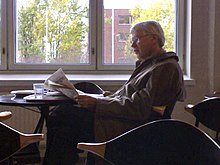Holmström model
In the model named after him, Bengt Holmström (currently Professor of Economics at the Massachusetts Institute of Technology ) deals with the hidden action problem (see Asymmetrical Information ) of the labor input of employees (about their career progression) and their implications for / for the Labor market or for the employee (hereinafter referred to as agent ). For his model, Holmström uses the assumptions of the principal-agent theory .
Holmström model
Holmström assumes a linear production function of the agent: = + + , where stands for the talent of the agent as a random variable, stands for the workload of the agent and is defined as an (exogenous) disturbance term (the expected value of is 0). The agent's talent is a priori normally distributed (see normal distribution ). The agent is risk-neutral (see risk neutrality / linear utility function ). The employer (hereinafter referred to as the principal ) can only observe the sum of the three summands of the agent's production function , but not individual summands such as B. the talent. Neither the summands nor the sum of these are contractible. Contractability is defined as verifiability by a third party. This assumption gives rise to the hidden action problem. The agent's output is observable, from which the principal is able, over time, to draw conclusions about the agent's unknown talent.
Implications: The agent can influence his future wages through his work and talent. Effort and talent are substitutes . In this way, an untalented agent can fake a certain amount of talent through high workload. As soon as t -> ∞, however, any uncertainty about the agent's talent has disappeared and his optimal workload would now be = 0 (for t = ∞). The question now arises, why does the agent not choose = 0 at the beginning of his career and thus save costs in the form of work suffering? (Work suffering is converted into monetary values in the agent's utility function for the sake of simplicity).
The solution is that the agent is in some kind of dilemma : the labor market / principal has ideas about the agent's behavior. If the agent deviates from the ideas, the labor market / principal would anticipate less talent and not assume less work. Due to these expectations, the agent has to work inefficiently at the beginning of his career in order to simulate the highest possible talent. With time (t -> ∞) his talent will be more and more observable by the labor market / principal ( -> 0 or = 0) and thus be almost known. It is worthwhile for the agent at the end of his career or when his talent is known to no longer show a high workload and he will choose an inefficiently low workload.
criticism
As a criticism of the Holmström model, it can certainly be said that talent and hard work are not perfect substitutes. In practice, talent can only be compensated for up to a certain threshold through the use of hard work. There are also certainly activities in which talent and effort are not substitutes at all (e.g. in professional sports).
See also
literature
- Bengt Robert Holmström: Managerial Incentive Problems: A Dynamic Perspective. In: The Review of Economic Studies. No. 66, 1999, pp. 169-182
- Robert M. Hutchens: Seniority, Wages and Productivity: A Turbulent Decade. In: The Journal of Economic Perspective. No. 3, 1989, pp. 49-64





